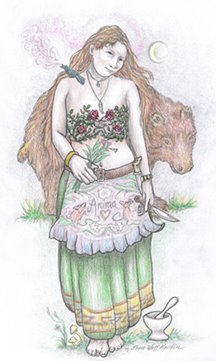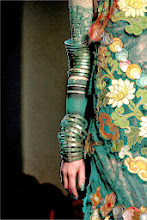 I was milling about in the heat of the day yesterday, trying to key out some wonderful smell traveling through the warm air.... strangely enough, it was emanating from this little purple and green leaved bush/vine creature whose identity I'd never been able to key out before. I looked down and the creature was bursting with creamy colored Honeysuckle blossoms! I've tried growing Japanese Honeysuckle here for the medicinal uses (and because I grew up in love with the feral Honeysuckle that had invaded my island home) but it always shriveled up and died in the dry air here. So imagine my absolute ~delight~ to find a Wild Canyon Honeysuckle vine/bush, and imagine my jumping up and down thrill to discover that the whole canyon is actually filled with them (all these evidently previously invisible green creatures) and just about to burst into bloom, prime time for harvesting!!!
I was milling about in the heat of the day yesterday, trying to key out some wonderful smell traveling through the warm air.... strangely enough, it was emanating from this little purple and green leaved bush/vine creature whose identity I'd never been able to key out before. I looked down and the creature was bursting with creamy colored Honeysuckle blossoms! I've tried growing Japanese Honeysuckle here for the medicinal uses (and because I grew up in love with the feral Honeysuckle that had invaded my island home) but it always shriveled up and died in the dry air here. So imagine my absolute ~delight~ to find a Wild Canyon Honeysuckle vine/bush, and imagine my jumping up and down thrill to discover that the whole canyon is actually filled with them (all these evidently previously invisible green creatures) and just about to burst into bloom, prime time for harvesting!!!
I've used the dried flowers on occasion and have always been impressed by their effects in wounds, cold/flu and fevers. I'll describe here my current knowledge and then, as with Pulsatilla, come back and update when I get to know the plant on a more intimate level.
Lonicera spp.
Names: Honeysuckle, Jin Yin Hua, Woodbine, Goat's Leaf
Energetics: cold, dry, bitter/sweet
Primary Actions: clears heat, alterative, immune stimulant, expectorant, diuretic, antispasmodic, strongly antiviral and antibacterial, anti-inflammatory, uterine stimulant, relaxant nervine, astringent, lymphatic
Primary organs: Stomach, lungs, liver
Parts used: flower buds (primary in TCM), flowers, leaves, stem, root (berries are said to be cathartic/emetic, haven't tried them). Most popular in Traditional Chinese Medicine, Honeysuckle also has a strong history of use among Native Amercians, Europeans and other peoples.
Most popular in Traditional Chinese Medicine, Honeysuckle also has a strong history of use among Native Amercians, Europeans and other peoples.
Like it's cousin the Elderberry, Honeysuckle is considered to be strongly antibacterial and antiviral, and Michael Tierra has even suggested that it is the "Echinacea of Chinese Medicine". Tierra also says that recent studies in China show it to be an effective treatment for certain cancers, especially breast cancer. My research indicates that flower has recently been successfully used in the clinical suppression and treatment of AIDS and has a history of widespread use with Pneumonia, asthma and respiratory infections/viruses. It is commonly utilized in TCM for acute cold and flu external type afflictions accompanied by fever and other heat signs. It is in this context I have had the most successful experience with and I plan on trying it together with Elderberry and Rosehip in the near future, I think they'll make a fabulous trio.
Because of it's broad antimicrobial action against a variety of bugs including strep, staph, salmonella and pseudomonas, it's very useful both internally and externally for any inflamed infection. Honeysuckle's mild and safe action make it safe in appropriate circumstances even in children and elders. It also has a place in the treatment of acute, hot urinary tract infections, damp heat in the stomach, ulcers, acute hepatitis, hot upper respiratory infections, menstrual cramps, arthritis and some forms of high blood pressure. I imagine it will be of use in hyperacid stomach conditions but have not yet confirmed this. The short list of uses above is not meant to be all inclusive, these are merely a few suggestions for what might be appropriate uses considering Honeysuckle's energy and affinities. Also, please note that this is a plant most suited for hot, feverish and acute problems as well as to overheated, hot excess people and not so much for the cold and deficient as it is very cooling in temperature.
Culpeper would disagree with me, and in fact said that:
Honeysuckles are cleansing, consuming and digesting, and therefore no way fit for inflammations. Take a leaf and chew it in your mouth and you will quickly find it likelier to cause a sore mouth and throat than cure it. If it be not good for this, what is it good for?
 Now I'm not sure what Honeysuckle Culpeper was chewing on, but our species is definitely cooling and is in fact, traditionally used for sore, inflamed throats. Perhaps European Honeysuckles are more warming than American or Asian? I'd love to know...
Now I'm not sure what Honeysuckle Culpeper was chewing on, but our species is definitely cooling and is in fact, traditionally used for sore, inflamed throats. Perhaps European Honeysuckles are more warming than American or Asian? I'd love to know...I've also found it to be exceptionally useful in stress headaches aggravated by heat (a common occurrence in New Mexico I'm afraid).
It's very healing on wounds, boils, psoriasis (use internally and externally), hot swellings, abscesses, rashes, skin irritations and the like. I've only used the diluted tincture and fomentation for this, but I'm going to be trying out an oil of the flowers and flower buds in the next week, I'm so hoping to infuse some of that intoxicating fragrance!
Based on my experiences with the plant, it seems to impart a sense of presence and appreciation of surroundings, allowing one to release tension or anxiety and be fully in the moment. I need to go check out the flower essence book though.
Considering the way Japanese Honeysuckle flourishes (most would say it is invasive, on par with Kudzu and Multiflora Rose, thank goodness they're all wonderfully medicinal plants) in many parts of the country and how many native species of Lonicera there are it seems as if this underused medicine should be granted a bit more popularity!
And in other news, I'm officially studying with Michael Moore now, his was my first herb book (not counting that silly Rodale's Herbal Encyclopedia I slept with all the time when I was like six, how embarrassing) and his knowledge of SW plants is so enormous I feel like I can't pass up an opportunity to work with my region's preeminent herbalist. I think I might have signed up just for the 4,000 plant monographs that comes with the course, good lord.... I'm also excited to see the Howie Brounstein is teaching lots of parts of the course, since I've always loved his work. There's also lovely sections on ethnobotany taught by great herbalists like Phyllis Hogan and Julie Cordero.
Oh, and I found Silk Tassel too, but that's another post...












4 comments:
I'd love to hear your experience of multiflora rose.
You mean of it's medicinal properties or just in general?
When I lived in Northern PA once upon a time, there were enormous amounts of Multiflora and everyone was constantly cursing it for it's tendency to invade and dominate the forest there. I can understand this, as it can knock the ecosystem out of balance.
The hips, as I recall, are wonderfully sweet and yummy and Rhiannon and I ate lots of them. The leaves are typical of Roses, astringent, slightly sweet. The flowers are wonderfully fragrant and I would expect them to be medicinally active though I didn't try them at the time.
Multiflora has a fierce spirit, I've always been impressed by her, but she's a bit pushy too.
Nice lonicera post, and congrats on starting the MM distance thingy!
Thanks Henriette, I like your lonicera photos on your site, do you use them medicinally?
I'm excited for the MM thing, specially with the residency periods, as well as for the phenomenal amount of information included, I love that he wants to make every student information autonomous!
Post a Comment